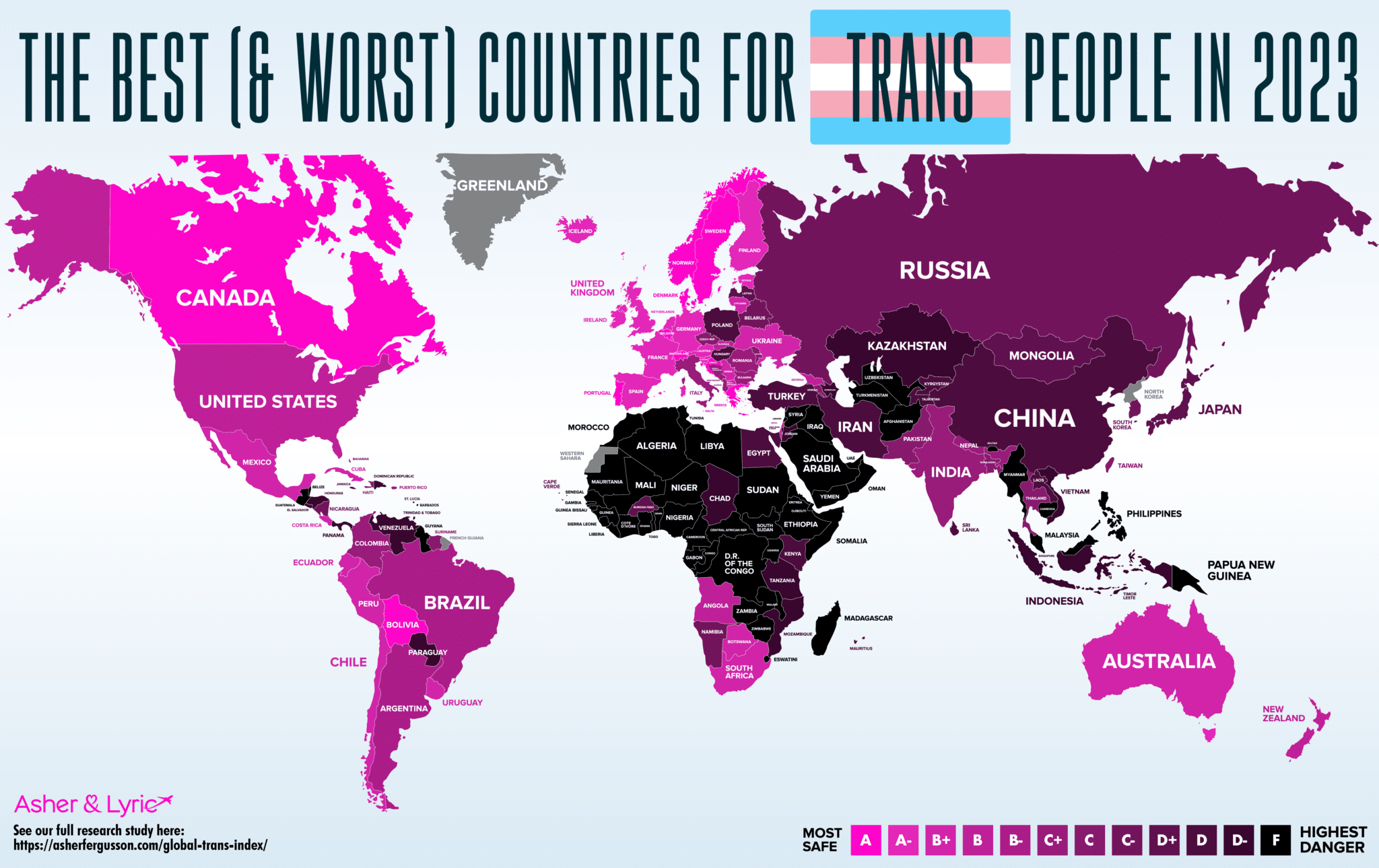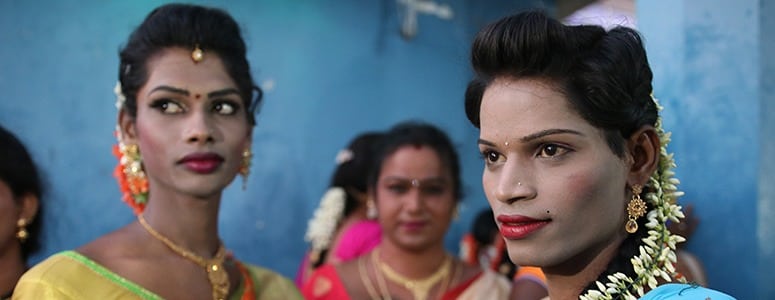
Transgender people are dealing with unprecedented issues around the world. While many countries are starting to find acceptance towards gay and lesbian relationships, there are still significant barriers for trans people.
Part of this has to do with a misunderstanding about transgender identities. Often, gender identity experiences will differ significantly between individuals and will also vary by culture. Many governments are struggling to keep up with the ever-changing conversation around transgender issues, and many countries are patently resistant to supporting their own citizens who identify as trans for a variety of reasons.
Transgender individuals often lack basic rights to self-determination and gender expression, necessary healthcare services, and a place in their community. This often leads transgender people to the margins of society, where poverty, substance use, and suicide rates skyrocket.
Some Stats From Around the Globe:
- In Australia, 63% of trans people identified verbal assault, and 22% reported physical assault. 33% reported workplace discrimination based on their gender identity.
- In the UK, 4 out of 5 transgender people reported being the victim of a hate crime within the past 12 months.
- A study shows that in Nigeria, trans people are facing huge barriers to receiving HIV resources because of stigma and fear of incarceration.
- Over 90% of trans individuals in Brazil reported discrimination based on their gender identity.
- One study in the United States found that at least one out of every two transgender individuals will be sexually assaulted in their lifetime.
- In many countries, transgender people are targeted with anti-homosexuality legislation, like two trans women in Cameroon who were sentenced to five years in prison for “attempting homosexuality” in 2021.
Transgender-Specific Issues Around the World
Trans people are experiencing barriers to safety, comfort, and medical services at far higher rates than the average person in society. As the data indicates, even the most “safe” countries still have instances of murder and violence against trans people because, globally, trans people are isolated, targeted, and pushed to the margins of society at much higher rates than their cisgender counterparts.
These are just some of the barriers that transgender people face around the world:
1. Violence
Transgender individuals are four times more likely to experience violence, according to one research study. Rates of violence and murder against transgender people are only growing in the United States, while violence against trans people remains a global (and underreported) problem. There are few reliable global resources for understanding trans violence, as many gay, bisexual, and transgender people are forced to live in the “Global Closet,” as one Yale School of Medicine study puts it. In much of the world, daring to live authentically is a dangerous, or even deadly, act.
2. Legislation
Many countries severely limit or outright criminalize transgender access to self-identification. This means that the government where they live does not recognize their gender ID or has significant roadblocks in place to gain that recognition.
Presenting as anything besides your gender assigned at birth carries criminal sentences in some countries. In fact, of the 203 countries included in our Global Trans Rights Index, only 43 countries allow trans individuals to change their legal gender ID without surgery or hormone therapy. An additional 46 allow legal gender to be changed after the individual undergoes often rigorous stipulations, like HRT, surgery, psychological diagnoses, extended and lengthy waiting times, and more.
Sixty-seven countries don’t allow for legal gender change whatsoever. There is either no legislation or processes in place to recognize a change in gender ID. And a further 27 countries outright criminalize legal gender change and impose harsh punishments (including jail time) on those who enter spaces or dress out of alignment with their assigned gender at birth.
3. Marginalization and Stigma
Few countries openly accept transgender people as part of society. Many trans people are ostracized from family, education, the workplace, religious institutions, and more. This commonly leads to “gender minority stress,” or the negative psychological and physiological impacts of being unaccepted by the community.
Transgender people face barriers to employment, inclusion in society, acceptance by family, ostracization from religion, and so much more. In the United States alone, approximately almost 11% of transgender people reported working in the sex work industry at some point. Other issues, such as class and race, only exacerbate the difficulties that transgender people face.
4. Health Impacts
Transgender people are twenty times more likely to die by suicide and are 13 times more likely to be HIV-positive, despite accounting for less than 1% of the population. Gender-affirming care, like hormone therapy and SRS (sex reassignment surgery), can be complicated and comes with myriad risks if not supervised adequately.
This is often combined with the fact that many health professionals around the world receive inadequate training in how to provide medical services for trans individuals. Not to mention the fact that stigma can also be present in the doctors, nurses, and medical staff that are supposed to be providing care. For those seeking gender-affirming medical treatment, there are often significant barriers to receiving this care and further barriers to receiving medical care post-surgery. Many countries don’t allow gender-affirming medical care at all.
5. A Basic Understanding of Transgender Issues
A complicated aspect of this study is digging through the legislation regarding legal gender identity and gender identity change. Different countries have different historical and religious approaches to how gender is expressed, understood, and respected.
Often, countries will require significant psychological, medical, and legal hoops before a gender identity change will be considered. Some countries are approving gender identity changes on a case-by-case basis, and some outright criminalize anyone who expresses in gender non-conforming ways with punishments including fines and jail time.
6. Underreported Crimes and Unsupportive Police
While trans people still experience unprecedented violence around the world, we still don’t know the full extent of the problem due to a severe underreporting problem. Often in countries where being transgender is illegal, those who experience violence fear further consequences for seeking help or reporting acts of violence against them. Going to the police as a transgender person can often result in further abuse, criminal charges, and even violence in many parts of the world.
This, combined with the fact that trans people are often pushed to the margins of society, only exacerbates the problem. Very few global statistics are available about trans people, as many of them are in extreme poverty. In the United States alone, transgender Americans are twice as likely to be living in poverty, and those in poverty have fewer resources and an overall lower quality of life.
7. Economic Limitations
Many countries report having legislation regarding legal protections for LGBTQ+ workers. And while this might be true in theory, there are two important factors to consider:
- Sexual orientation is more often a protected class than gender identity
- Laws are frequently unenforced
So while a country may claim to have legislation to protect transgender employees, the reality is often far less hopeful, and trans individuals may be passed over for employment opportunities, receive fewer supports on the job, and be overlooked for advancement opportunities based on their gender identity compared to their cisgender counterparts.
8. The “Global Closet”
In our study, you may notice that countries with higher trans safety scores also often have frequent instances of reported trans murders on the Trans Murder Map project. While this may, in part, be attributed to how certain countries handle and report on trans murders, part of this might be due to the fact that many people in much of the world are still living in the Global Closet.
The Global Closet refers to areas in the world where it is illegal, unsafe, or even punishable by death to be “out” as an LGBTQ+ person. LGBTQ+ people in these countries often live and operate outwardly as heterosexual and gender-conforming for fear of retaliation, imprisonment, or worse if they were to live their authentic lives. Unfortunately, there are still many, many places in the world where living “in the closet” is often the safest route for gay and trans people, but this can have negative psychological and emotional consequences.










